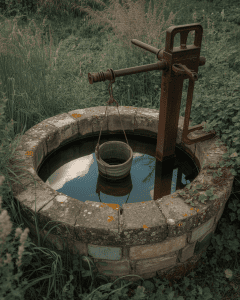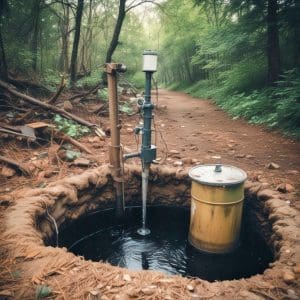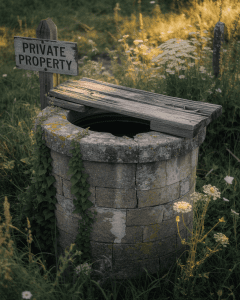 Abandoned wells, whether from oil, gas, or water extraction, pose significant environmental risks when left improperly sealed. These wells, often relics of past industrial activities, can contaminate groundwater, release harmful gases, and disrupt ecosystems. Proper sealing and restoration are critical to mitigating these impacts, ensuring environmental safety, and complying with regulatory standards. Of course, are primary focus here is on abandoned water wells. This article explores the environmental consequences of abandoned wells and underscores the importance of effective sealing and restoration practices.
Abandoned wells, whether from oil, gas, or water extraction, pose significant environmental risks when left improperly sealed. These wells, often relics of past industrial activities, can contaminate groundwater, release harmful gases, and disrupt ecosystems. Proper sealing and restoration are critical to mitigating these impacts, ensuring environmental safety, and complying with regulatory standards. Of course, are primary focus here is on abandoned water wells. This article explores the environmental consequences of abandoned wells and underscores the importance of effective sealing and restoration practices.
Environmental Impacts of Abandoned Wells
Abandoned wells, if not properly sealed, can act as conduits for environmental contamination and pose long-term risks to ecosystems and human health. The following sections detail the primary environmental impacts associated with these wells.
Groundwater Contamination
One of the most significant risks of abandoned wells is groundwater contamination. Wells that are not properly sealed can allow contaminants, such as hydrocarbons, heavy metals, or brine, to migrate into aquifers. This can compromise drinking water supplies and affect agricultural systems. For instance, oil and gas wells may leak residual chemicals or methane into groundwater, leading to toxic exposure for communities and wildlife.
contaminants, such as hydrocarbons, heavy metals, or brine, to migrate into aquifers. This can compromise drinking water supplies and affect agricultural systems. For instance, oil and gas wells may leak residual chemicals or methane into groundwater, leading to toxic exposure for communities and wildlife.
Mechanisms of Contamination
The structural failure of well casings or inadequate sealing materials can create pathways for contaminants to move from deep geological formations to shallow aquifers. Studies have shown that improperly sealed wells can lead to detectable levels of methane and volatile organic compounds (VOCs) in nearby water sources (Jackson et al., 2013).
Greenhouse Gas Emissions
Abandoned wells are a significant source of greenhouse gas emissions, particularly methane, a potent greenhouse gas with a global warming potential significantly higher than carbon dioxide. Leaking wells can release methane into the atmosphere, contributing to climate change.
Long-Term Climate Implications
Unmitigated methane leaks from abandoned wells exacerbate global warming, undermining efforts to reduce greenhouse gas emissions. These leaks can persist for decades, making timely sealing critical to climate change mitigation.
Surface and Soil Contamination
Abandoned wells can also lead to surface and soil contamination. Leaking fluids, such as oil or brine, can spill onto the surface, degrading soil quality and harming vegetation. These spills can disrupt local ecosystems and render land unsuitable for agriculture or development.
Ecological Damage
Contaminated soils can reduce biodiversity by affecting plant growth and soil microorganisms. Wildlife that comes into contact with contaminated areas may suffer from toxic exposure, leading to population declines or behavioral changes.
Aesthetic and Land Use Impacts
Leaking wells can create unsightly pools of oil or chemicals, reducing the aesthetic and economic value of the land. This can hinder redevelopment efforts and affect local communities reliant on tourism or agriculture.
Seismic and Structural Risks
In some cases, abandoned wells can contribute to seismic activity or ground instability. Improperly sealed wells may allow fluid migration that alters subsurface pressures, potentially triggering small earthquakes or subsidence.
Induced Seismicity
Regions with extensive well abandonment, such as Oklahoma, have reported increased seismic activity linked to fluid migration from poorly sealed wells. While the risk is generally low, it underscores the need for proper well closure to maintain geological stability (Ellsworth, 2013).
 Importance of Proper Sealing and Restoration
Importance of Proper Sealing and Restoration
Proper sealing and restoration of abandoned wells are essential to mitigate the environmental risks outlined above. These processes involve plugging wells with durable materials, restoring the surrounding land, and monitoring for long-term integrity.
Well Sealing Techniques
Effective well sealing requires the use of cement and other durable materials to permanently close off the wellbore, preventing fluid or gas migration.
Cement Plugging
The most common method involves placing cement plugs at strategic depths within the well to block pathways for contaminants. The cement must be resistant to corrosion and compatible with the geological environment to ensure long-term stability.
Regulatory Standards
Many countries have established regulations for well sealing. In the United States, for example, the Environmental Protection Agency (EPA) and state agencies set standards for well abandonment to protect groundwater and surface environments (EPA, 2021).
Site Restoration
Beyond sealing the well, restoring the surrounding land is critical to minimizing environmental impacts. Restoration involves removing surface equipment, remediating contaminated soils, and revegetating the area to restore ecological function.
Soil Remediation
Contaminated soils may require excavation, treatment, or replacement to restore fertility and prevent further environmental harm. Bioremediation techniques, such as using microorganisms to break down hydrocarbons, can be effective in cleaning up contaminated sites.
Revegetation and Ecosystem Recovery
Planting native vegetation helps stabilize soil, prevent erosion, and support local wildlife. Successful restoration can return the site to a state that blends with the surrounding ecosystem, enhancing biodiversity and land usability.
Economic and Social Benefits
Proper sealing and restoration not only protect the environment but also provide economic and social benefits. Restored sites can be repurposed for agriculture, recreation, or development, boosting local economies. Additionally, mitigating contamination risks protects public health, reducing healthcare costs and improving community well-being.
Job Creation
Well sealing and restoration projects create jobs in environmental engineering, construction, and monitoring. These projects can stimulate local economies, particularly in regions with a high density of abandoned wells.
Community Trust
Addressing abandoned wells demonstrates a commitment to environmental stewardship, fostering trust between communities, industries, and regulators. Transparent restoration efforts can improve public perception of resource extraction industries.
Challenges and Future Directions
Despite the importance of proper sealing and restoration, challenges remain, including funding constraints, locating abandoned wells, and ensuring long-term monitoring.
Orphaned Wells
Many abandoned wells are classified as “orphaned,” meaning they lack a responsible owner to fund sealing and restoration. Governments and organizations are increasingly developing programs to address these wells, but funding and logistical challenges persist.
Technological Innovations
Advances in technology, such as remote sensing and machine learning, are improving the ability to locate and assess abandoned wells. These tools can help prioritize high-risk wells for sealing and monitor sites post-restoration.
Policy and Collaboration
Stronger policies and international collaboration are needed to address the global challenge of abandoned wells. Incentives for industry compliance and public-private partnerships can accelerate efforts to mitigate environmental risks.
Conclusion
Abandoned wells pose significant environmental risks, including groundwater contamination, greenhouse gas emissions, and soil degradation. Proper sealing and restoration are critical to mitigating these impacts, protecting ecosystems, and supporting sustainable land use. By adhering to regulatory standards, employing effective sealing techniques, and restoring affected sites, industries and governments can address the legacy of abandoned wells. Continued investment in technology, policy, and community engagement will be essential to ensuring a safer and healthier environment for future generations.
Sources and Citations
- Davies, R. J., Almond, S., Ward, R. S., Jackson, R. B., Adams, C., Worrall, F., … & Whitehead, M. A. (2014). Oil and gas wells and their integrity: Implications for shale and unconventional resource exploitation. Marine and Petroleum Geology, 56, 239-254. https://doi.org/10.1016/j.marpetgeo.2014.03.001
- Ellsworth, W. L. (2013). Injection-induced earthquakes. Science, 341(6142), 1225942. https://doi.org/10.1126/science.1225942
- Environmental Protection Agency (EPA). (2021). Underground injection control regulations and safe drinking water act. Retrieved from https://www.epa.gov/uic
- Jackson, R. B., Vengosh, A., Darrah, T. H., Warner, N. R., Down, A., Poreda, R. J., … & Karr, J. D. (2013). Increased stray gas abundance in a subset of drinking water wells near Marcellus shale gas extraction. Proceedings of the National Academy of Sciences, 110(28), 11250-11255. https://doi.org/10.1073/pnas.1221635110
- Kang, M., Christian, S., Celia, M. A., Mauzerall, D. L., Bill, M., Miller, A. R., … & Jackson, R. B. (2020). Identification and characterization of high methane-emitting abandoned oil and gas wells. Environmental Science & Technology, 54(22), 14627-14636. https://doi.org/10.1021/acs.est.0c04492

 Importance of Proper Sealing and Restoration
Importance of Proper Sealing and Restoration
0 Comments